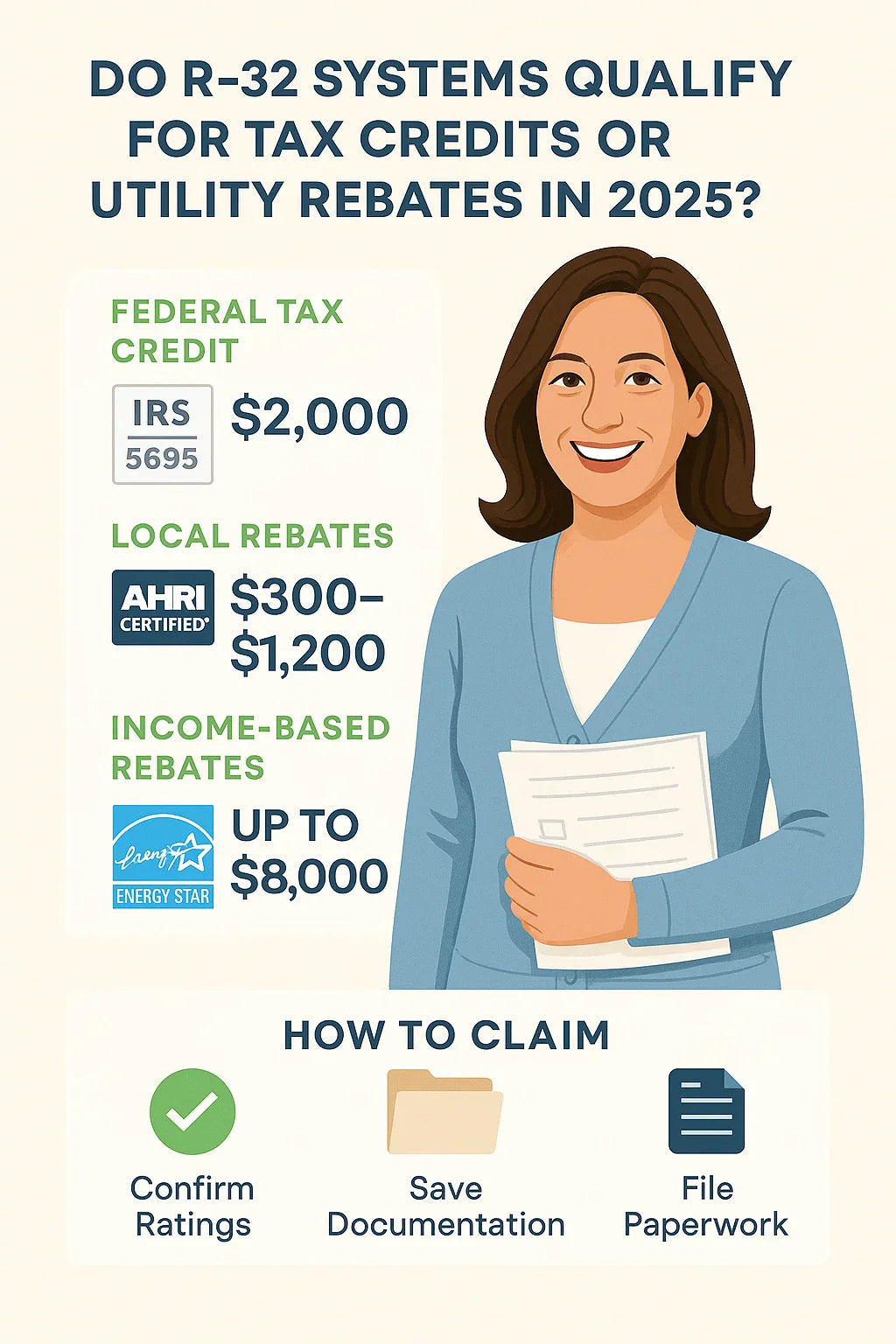Unlock thousands in potential savings by understanding how energy-efficient R-32 AC systems qualify for rebates, incentives, and federal tax credits.
💰 Introduction: HVAC Upgrades That Pay You Back
Home upgrades don’t always come with a return—but switching to a high-efficiency air conditioner with R-32 refrigerant in 2025 absolutely can. If you’re like Samantha Reyes and want to make a smart, eco-conscious investment that pays off, you might be surprised how much money you can recoup.
Thanks to the Inflation Reduction Act (IRA), ENERGY STAR® rebates, and dozens of state/local programs, many R-32 AC systems qualify for incentives of $500–$3,200 or more.
Let’s explore how to unlock those savings.
📦 What Is an R-32 System?
R-32 systems use a low global warming potential (GWP) refrigerant called Difluoromethane (R-32) in place of R-410A. They are often:
-
More energy-efficient (up to 10–30%)
-
SEER2-compliant
-
Future-ready under 2025 refrigerant phase-down regulations
If you’re installing a 3-ton R-32 split system (outdoor condenser + indoor air handler), you’re likely eligible for multiple credits and rebates—if the system is properly matched, rated, and certified.
📋 2025 Federal Tax Credit: What You Need to Know
🧾 1. Inflation Reduction Act – 25C Energy Efficiency Home Improvement Credit
As of 2025, homeowners can claim a nonrefundable federal tax credit of:
-
Up to $2,000 for qualified central AC systems
-
Includes installation and labor
-
Renewed annually (you can reapply if you do phased upgrades)
✅ Eligibility Checklist
| Requirement | Criteria |
|---|---|
| Home type | Primary residence (owned) |
| Efficiency rating | Meets or exceeds 15.2 SEER2 |
| AHRI certificate | Must match indoor & outdoor units |
| Installation date | After January 1, 2023 |
| Installer paperwork | Keep invoice + AHRI cert on file |
💡 Samantha’s Tip: You must file IRS Form 5695 with your federal tax return to claim the credit.
🔌 2. High-Efficiency Electric Home Rebate Act (HEEHRA)
Part of the broader IRA, this program offers point-of-sale rebates for low- to moderate-income households upgrading to high-efficiency, electric HVAC systems—including those using R-32 refrigerants.
💸 Rebate Structure (Income-Based)
| Household Income (Area Median) | Rebate Amount |
|---|---|
| ≤ 80% AMI | 100% of cost, up to $8,000 |
| 81%–150% AMI | 50%, up to $4,000 |
| > 150% AMI | Not eligible |
These rebates are stackable with 25C federal credits and apply at checkout, so no waiting for a refund.
🔗 Rewiring America Rebate Calculator
🔎 3. ENERGY STAR® Certified Systems — Rebates by Manufacturer and Retailer
R-32 systems often carry the ENERGY STAR label due to their high SEER2 efficiency. This makes them eligible for:
-
Manufacturer rebates (e.g., Daikin, Carrier, Goodman)
-
Retailer promotions (via Lowe’s, The Furnace Outlet, etc.)
-
HVAC distributor incentives
📎 Use the ENERGY STAR Rebate Finder to search by product type and ZIP code.
🌎 4. State and Local Utility Rebates (Examples)
Hundreds of utilities across the U.S. offer local rebates to offset the cost of high-efficiency cooling systems.
🔦 Example: Duke Energy – North Carolina
-
$300–$600 for installing ENERGY STAR® central AC
-
R-32 systems qualify if SEER2 ≥ 15.2
-
Must use a participating contractor
🔗 Duke Energy Rebates Page
🔦 Example: LADWP – Los Angeles
-
Up to $1,200 back for split-system AC upgrades
-
Must meet Title 24 compliance + ENERGY STAR®
🔗 LADWP HVAC Incentive Portal
🔦 Example: Xcel Energy – Minnesota/Colorado
-
Up to $500 for SEER2 15+ systems
-
$75 bonus for Wi-Fi thermostat integration
🔗 Xcel Residential HVAC Rebates
💡 Tip: Use DSIRE USA to search rebates by ZIP and utility provider.
📂 How to Claim These Credits and Rebates
🛠️ Step-by-Step: Federal Tax Credit (25C)
-
Confirm SEER2 Rating + AHRI Certificate
-
Get a matched set AHRI certificate from your contractor or download from ahridirectory.org
-
-
Save Your Paperwork
-
Invoice, installer receipt, AHRI certificate
-
-
File IRS Form 5695
-
Attach to your annual tax return
-
-
Apply credit to your return
-
Can reduce taxes owed or increase refund
-
🧾 Step-by-Step: Utility Rebate
-
Visit your utility’s HVAC rebate page
-
Download and fill out rebate forms
-
Include:
-
Installer invoice
-
Copy of AHRI certificate
-
System serial/model numbers
-
-
Submit within 90–180 days of installation
-
Receive rebate as a check or utility bill credit
🏠 Samantha’s Real Example: R-32 Rebate Breakdown
Location: Louisville, KY
System: 3-ton R-32 split system (SEER2 16.2)
Air Handler: Variable-speed ECM blower
Installed Cost: $7,900
Incentives Received:
| Source | Amount |
|---|---|
| Federal Tax Credit (25C) | $2,000 |
| Local Utility (LG&E) | $500 |
| Manufacturer Promo | $250 |
| Total Savings: | $2,750 |
Net cost after incentives: $5,150
⚠️ Common Mistakes to Avoid
🚫 Don’t assume all R-32 systems qualify — check SEER2 ratings
🚫 Don’t mix/match unlisted indoor & outdoor units
🚫 Don’t skip the AHRI certificate — required for both rebates and IRS
🚫 Don’t wait too long — most rebate programs have deadlines (90–180 days)
📋 Final Takeaways: How to Maximize Your R-32 Savings
✅ Choose an R-32 system rated 15.2 SEER2 or higher
✅ Confirm it is AHRI-certified and ENERGY STAR® listed
✅ Work with a contractor who knows rebate paperwork and form 5695
✅ Stack savings using federal + utility + manufacturer + income-based rebates
✅ Claim before deadlines and keep all documentation
By planning wisely—like Samantha—you can cut 25–50% or more off your system’s cost in 2025.







